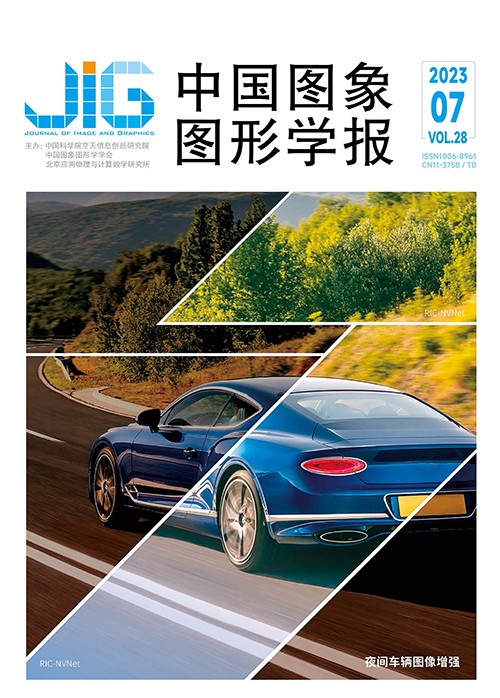
面向真实图像噪声的两阶段盲去噪
摘 要
目的 现有的深度图像去噪算法在去除加性高斯噪声上效果显著,但在去除任意分布的真实图像噪声时表现不佳;去噪模型的深度在不断增加,但去噪效果上却并未能显著提高。对此,设计了一种简单有效的两阶段深度图像去噪算法。方法 首先基于注意力机制估计真实图像上的噪声分布水平,然后使用一个混合膨胀卷积和普通卷积的多尺度去噪模块进行非盲降噪。结果 在DND (darmstadt noise dataset)、SIDD (smartphone image denoisingdataset)、Nam和PolyU (the Hong Kong Polytechnic University)等4个图像去噪领域常用数据集上进行去噪实验,选择峰值信噪比(peak signal-to-noise ratio,PSNR)和结构相似性(structual similarity,SSIM)作为去噪效果的评价指标,得到的平均PSNR值分别为39.23 dB,38.54 dB,40.45 dB,37.34 dB,并与几种传统去噪方法和基于深度学习的去噪方法进行比较。实验结果表明,本文的去噪算法在去噪效果和视觉质量上有明显提升。同时,在SIDD数据集上进行消融实验以验证算法中模块的有效性。结论 本文算法使用的跳跃连接、噪声水平估计以及多尺度模块均可以有效提升真实图像去噪效果。与现有方法相比,本文算法不仅能有效去除真实图像噪声,而且能通过简单的模块参数设置控制去噪网络的计算效率。
关键词
A dual of real image noise-related blind denoising technique
Ding Yuehao, Wu Hao, Kong Fengling, Xu Dan, Yuan Guowu(School of Information Science and Engineering, Yunnan University, Kunming 650500, China) Abstract
Objective Image denoising technique can be as one of essential aspects in relevance to low-level vision. For image processing tasks,preprocessing is required for such contexts of high image quality,image segmentation,finegrained detection and flaw detection. For real life scenario,image noise is inevitable because the image is collected and defected from the digital device itself,which will affect people’ s visual perception of the image. Image denoising-related research is originated from removing additive Gaussian white noise. There is a great difference between additive Gaussian white noise and real noise. The causes of real noise are diverse,and its distribution is different from that of Gaussian noise. The distribution of real noise is complex and may not only manipulated for one distribution,in which poor denoising results are obtained in terms of the removal of real noise. Moreover,traditional image denoising methods are required to set parameters manually,and deep learning based denoising algorithm has a poor effect in removing real noise. To get better results of denoising,the network model of these denoising methods is complex and time-consuming,but actual denoising effect is not significantly improved. It is difficult to use an end-to-end algorithm to remove real image noise well beyond nonblind noise reduction. Therefore,we develop a dual of real image denoising model based on deep learning,which uses a simplified network structure and has ideal denoising results and visual performance on the image denoising dataset. Method A blind denoising network model of two-stage modular denoising network(TMNet)is designed and illustrated, which is divided into two stages,the first stage is concerned of noise level estimation,and the second stage is concerned of non-blind denoising of the image. For the noise level estimation,a 4-layer fully convolutional neural network is used to estimate the noise level of the input image. The pooling layer is not used,but a convolutional layer is linked with a convolution kernel size of 3 only,and a padding operation is performed after the convolutional layer to keep the obtained feature size consistent from each layer. At the same time,due to the attention mechanism can effectively extract network features and improve network performance,before the last convolutional layer,the squeeze and excitation(SE)module can be used to process the features obtained via the noise level estimation,and such weights is adaptively assigned to the features of different channels. Finally,the estimated noise level and the input image are used as the output of this stage. The non-blind denoising stage can be focused on taking the estimated noise level and the image together as the input of this stage,and real image denoising becomes the problem of image denoising,which can remove the known noise distribution level. At this stage,we design a multi-scale structure,which can melt image features into two branches for processing. One branch is as an expanded convolutional layer,and the other branch is as an ordinary convolutional layer as well. Dilation convolution can be applied to get a larger receptive field by injecting holes into features of non-additional new parameters. In this way, image characteristics can be obtained under different receptive fields. The algorithm is designed for those skip connections are used in the multi-scale structure because effective skip connections are appeared in image denoising,and the loss of image information will be reduced in the process of parameter transmission when the number of network layers increases. For the convolution operation used in the non-blind denoising stage,the size of the convolution kernel is 3,and the corresponding padding operation is also guaranteed that the size of the image feature will not change in the entire network. Due to the high resolution of the original image of the smartphone image denoising dataset(SIDD)dataset used in the training model,our experiment is focused on dividing the image into 256 patches and performs 4 000 epochs of training randomly. The loss function used is L1 loss. All experiments are done on NVIDIA GTX 2080ti GPU. Result Four sort of commonly used datasets in image denoising fields including darmstadt noise dataset(DND),SIDD,Nam,and the Hong Kong Polytechnic University(PolyU)are used to verify the effectiveness of the algorithm,and the peak signal-to-noise ratio(PSNR) and structural similarity(SSIM)are used to evaluate the denoising results. Denoising experiments are carried out on DND,SIDD,Nam,and PolyU datasets,and the average PSNR values obtained are 39. 23 dB,38. 54 dB,40. 45 dB, and 37. 34 dB,respectively. Compared to the traditional algorithm,the denoising effect and visual sense are significantly improved,and the denoising effect can be similar to that of the deep learning denoising algorithm in related to fewer network layers. Furthermore,ablation experiments are designed to verify the effectiveness of the methods proposed,such as skip connection,channel attention,and noise level estimation. Experiments show that our methods proposed can effectively improve the effect of real image denoising to a certain extent. Conclusion We design a convolutional neural network(CNN) model for removing noise from real images. Our model has a simple network structure,in which most of the convolution operations with a convolution kernel size of 3 are carried out,and the network training speed is fast. Our network can get richer residual structure in image denoising as well. Additionally,we use multiple convolution to obtain more effective feature information. Experimental results show that our network is potential to removing real image noise further to some extent.
Keywords
|



 中国图象图形学报 │ 京ICP备05080539号-4 │ 本系统由
中国图象图形学报 │ 京ICP备05080539号-4 │ 本系统由